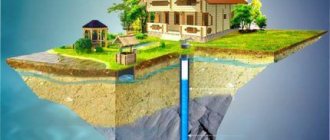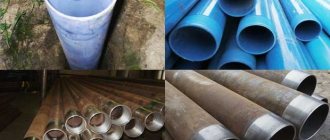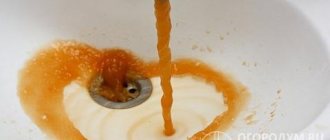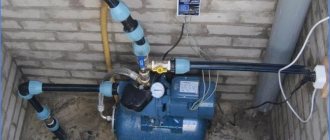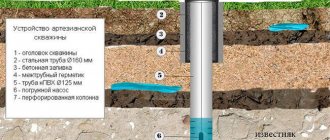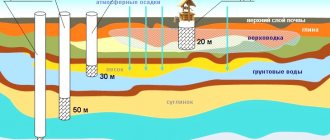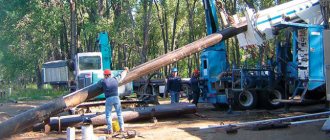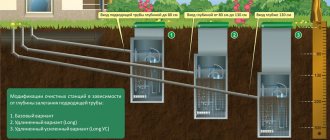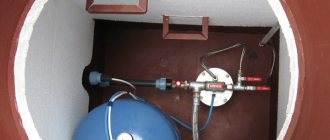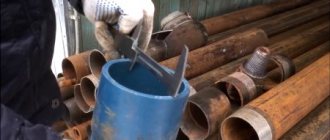Your own dacha or cottage, like any residential building, must provide its residents with maximum amenities, i.e. it cannot be done without a water supply. Therefore, the water supply to a private house from a well must be designed taking into account all water intake points not only in the building, but also in the local area, which may contain: a bathhouse, a summer kitchen and a tap for watering the garden.
To properly install water supply from a well, you will first need to equip the source itself, make a caisson, install a pump, dig a trench and lay a pipeline in it. In the house itself it will be necessary to install a water treatment system, install a boiler and install pipes.
Setting up a water supply on your own is quite a difficult task, however, if you act consistently and according to a clear scheme, the installation will turn out to be quite doable.
Main components of the water supply system:
- Source of water intake (sandy or artesian - depends on the depth of the aquifer).
- Pump – submersible or surface pump.
- Storage tank (500 l for a family of 3 people).
- Equipment (coarse and fine filters).
- Boiler.
Source device: choose the best one
To supply water year-round to your country house, sand or artesian wells are most often used. Let’s take a closer look at which one is best suited for your site.
A sand well can provide clean running water to a small house and its surrounding area, based on an average consumption of no more than 1.5 cubic meters. m/hour. It is ideal for a summer house or small cottage.
It is drilled to a depth of 10 to 50 meters, which is enough in most cases. The liquid in such a well is usually clean, but nevertheless, the installation of filters is mandatory, as it may contain various impurities. The productivity is quite modest, no more than 5 cubic meters per hour, and its service life is usually within 10 years.
If you plan to live in your home all year round and have water supply from a well, then an artesian will be the ideal choice.
It is drilled to a depth of more than 100 meters. The main advantage is considered to be a huge supply of clean water. It is capable of delivering up to 10 cubic meters/hour. Usually this is enough for uninterrupted water supply to a large house with a plot in which 4–6 people live. With proper care, it can last at least fifty years.
Types of wells
There are several main types of sources, which differ in depth and device technology:
- sand well – has a depth of 15-30 meters;
- needle is another name for the Abyssinian well. Usually does not exceed 15 meters in depth, it is considered one of the best options for a private home, but has a number of geological restrictions;
- an artesian well is the most expensive type, has a depth of more than 50 meters and is fed from limestone layers.
All types have their advantages and disadvantages. They also differ in manufacturing cost and arrangement technology. You can read more about this in the article “The principle of operation of a well.”
Different types of wells
How to bring water into the house
The principle of water supply is relatively simple and involves the presence of a small caisson - a reservoir located above the source, which contains equipment for controlling the well pump. If the winters in your region are not cold, a hydraulic accumulator is installed in the caisson.
The caisson can be made of plastic, metal or brick. Afterwards, a trench is dug from it to a depth of 15–20 cm below the freezing point of the soil. A pipeline is laid at the bottom through which water will be supplied. An electrical cable must also be laid in the trench, from which the submersible pump will subsequently be powered.
Winter option. If winters in your region are very cold, you need to insulate the water supply to your home.
The water treatment system is calculated for each site individually, depending on the analysis of water from the well. In this case, filters should be installed immediately before the entrance to the storage tank. Actually, this is exactly what the water supply scheme for a private house from a well with a hydraulic accumulator looks like.
Why do you need a caisson?
In addition to protecting the well head from freezing in winter, the caisson must have reliable waterproofing of the walls and floor, and also protect the equipment from precipitation.
1. Hatch. 2. The entry point of the pipe going to the consumer. 3. Corrugated walls make the caisson stronger. 4. The ladder allows you to easily descend into the caisson. 5. At the bottom of the caisson there is a prepared pipe for the well head
Caissons can be made yourself from brick or concrete (like a strip monolithic foundation). But there are enough offers for the sale of ready-made forms made of metal or plastic, with a hermetically sealed lid, ladder, holes for the well head and utility lines.
The sizes of caissons can be different: from a relatively small pipe in diameter (so that a person can fit in when servicing the equipment), to a full-fledged “cellar”, in which there is enough space even for a storage tank.
A steel caisson is much stronger than a plastic one, but it is also heavier and difficult to install in place
Installation of water supply from a source under the house
It is possible to make a well inside a house, but due to some difficulties associated with the rather large dimensions of a conventional drilling rig. It follows from this that the mine will have to be drilled using a MGDU, which can be disassembled and carried inside.
You can do it even simpler: drill a well in advance, even at the stage of building the box, namely during the construction of the foundation. In such a situation, a conventional drilling rig will help you, and you will not need to overpay for drilling with the help of a MGBU, the services of which are usually more expensive.
Let us remember that the main purpose of a well in a house is to save money, since if the source is located in a warm basement, then there is no need to install a caisson, dig a trench, lay a water supply system and its thermal insulation. According to the most conservative estimates, installing a well under a house can save at least 30 thousand rubles.
Difficulties may arise during maintenance of the mine and the water supply itself. The fact is that it is unlikely that there will be much space in your basement for pumping equipment, filters and a hydraulic accumulator, and this imposes its own limitations.
Series connection of water intake points
This method is known as the tee method. When installing a serial connection, all points, such as a sink, shower, washbasin, are connected to the system in series, that is, one after another on one pipe. This method significantly reduces the cost of water supply, since much less consumables are required. A significant disadvantage of a series connection is the possibility of reducing the pressure in the system, which will be greater the further the drainage point is from the pump.
Parallel connection of water intake points
A parallel, or collector, connection is a method of installing a home water supply system in which a separate line is drawn for each water intake point. This system makes it possible to provide the same pressure for all consumers, but the cost also increases significantly.
Storage tank - purpose and placement options
Apart from the cost of the well itself, the pump is the most expensive element of an autonomous water supply system. Essentially, this is an electric motor, and for it the most “extreme” mode is start-up. Frequent stops and starts lead to a decrease in resource.
To reduce the number of trips and not turn on the pump every time the tap is opened, use a storage tank. It accumulates an “operational” supply of water, and the automation turns on the pump when the level drops to the minimum level and turns off when it reaches the maximum. To do this, you need a float switch (set to two levels) or a pressure sensor that will control the start of the pump. Moreover, the control can be built on the principle of a variable-frequency electric drive, with soft start and stop of an asynchronous electric motor.
There are two options for placing a hydraulic accumulator: on the same level with the well head and in the attic or attic of the house (if they are insulated and heated).
Layout of the storage tank at the same level with the well head. 1. Caisson. 2. Well. 3. Storage capacity. 4. External water supply, laid below the freezing level. 5. Pumping station. 6. Internal water supply
Layout of the storage tank in the attic. 1. Caisson. 2. Well. 3. Internal water supply. 4. Storage capacity. 5. Internal water distribution
In the first case, to supply water to consumers, another pump is needed, or rather, a pumping station, which turns on when the tap is opened and the pressure in the pipe decreases (the control circuit contains a check valve and a pressure switch). The pressure in such a system is consistently high, but the operation of the internal water supply will depend on the electrical network.
In the second case, the water supply to the points occurs “by gravity”, but the water from the head will have to be raised a few more meters, and this is an additional load on the submersible pump. In addition, the pressure in the system will be low and depend on the water level in the container.
Do-it-yourself plumbing according to the diagram
Let's look at the water supply system step by step using the collector connection method as an example:
- A shut-off valve is installed after the storage tank, followed by a tee.
- In the tee, the water flow is divided into two directions - for the filtration system and for other needs that do not need purified liquid (watering the garden, washing a car, washing machine).
- Water is supplied to a deep filter.
- Then a tee is installed, from which the cold and hot water line is supplied. It goes into the heater and is then distributed.
Water treatment system
Well water needs purification. It begins already at the stage of water intake, since solid suspended particles have a bad effect on the operation of the pump. In the future, to bring the water quality to the required level, a whole water treatment system is needed.
Water treatment complex. 1. Coarse filter. 2. Aerator. 3. Iron removal filter. 4. Softening filter. 5. Regeneration tank with salt concentrate. 6. Fine filter. 7. Ultraviolet disinfectant. 8. Compressor. 9. Bypass line tap
The first coarse filter is placed in front of the storage tank. It reduces the load on the pumping station. But after it, the water can only be used for irrigation. And for the operation of a boiler, heating system, dishwasher and for personal hygiene, water must be of drinking quality - small suspended particles and salts lead to deposits in the form of sediment and scale, and this will lead to equipment failure.
The specific configuration of the purification system can only be built on the basis of laboratory water analysis. The most common components of water treatment include:
- fine filter from mechanical impurities;
- water softener (reduces carbonate and non-carbonate hardness);
- purification from iron ions;
- chlorination or ultraviolet sterilization, another fine filter (carbon or fine-grained sand);
- decrease in acidity.
As a separate option, a reverse osmosis filter can be installed in the water treatment system to obtain drinking water of the highest quality. It is after this that water is best suited for cooking and drinking.
Rules for laying pipes in the house
When installing a home water supply from a well, you should approach the choice of the diameter of the water pipes with the utmost responsibility, because the overall throughput and noise level depend on it.
To calculate the size, you should start from the approximate length of each individual line; the calculation is carried out from the accumulator to the water intake point:
- for a line less than ten meters long, the use of pipes Ф16-20 mm is allowed,
- for a route about thirty m long - Ф25 mm,
- more than forty-five meters long and not less than 32 mm.
Important: choose the diameter of the collector pipe correctly. If the system is small, it will not work correctly and will not be able to provide the necessary pressure for comfortable use by all consumers.
The water supply from the collector should be calculated taking into account the fact that about 5 liters flow through a regular tap in one minute. Knowing this indicator, you should calculate the amount of water consumed simultaneously from all points at peak moments; based on this indicator, the diameter of the collector is selected:
- 25 mm at a consumption of 30 l/min,
- 32 mm at a consumption of 50 l/min,
- 38 mm at a consumption of 75 l/min.
Choosing pipes for water supply
- Products made of copper are considered to be the best, as they do not rust, have high strength and a long service life. The main disadvantage of copper products is their high cost.
- Metal-plastic products have also gained great popularity. This is due to the fact that such pipes are made of corrosion-resistant aluminum, coated on both sides with a thin polyethylene film. This multi-layer system makes it possible to guarantee high corrosion protection and tear resistance. In addition, the internal polyethylene coating is more resistant to deposits than metal products.
- Polypropylene is characterized by maximum durability and ease of installation. Also, one of the advantages of such products is their low cost and equipment. For example, the price of a simple soldering iron, with which you can lay water pipes throughout the house, rarely exceeds 800–1000 rubles.
Practical tips for installing piping around the house
For year-round operation of a water supply system from a well, you should use the following tips:
- The ideal home plumbing is done in such a way as to prevent pipes from passing through the walls of the premises. But, since the lining leads to a significant increase in the cost of the system, the pipeline is laid inside the walls, but using a protective metal cup, which protects them from deformation caused by shrinkage of the building.
- It is necessary to ensure a minimum gap of at least 20–25 mm between parallel pipes and building structures. This will greatly simplify future repairs. If you do not want to leave the wiring in plain sight, you should hide it in pre-prepared grooves, insulating them at the same time.
- If the water supply system is equipped with drain taps, they should be installed at the lowest points of the system so that water can flow through the drain tap by gravity.
- The easiest method for attaching pipes to walls is using plastic crabs. The distance between them should not exceed two meters with a pipe diameter of 16–20 mm; with a larger size, the distance between the fasteners should be smaller. A well-organized and executed water supply system has the following features:
- Has a minimum number of welded joints. This makes it possible to significantly increase the reliability of the units, while a less powerful and therefore cheaper pump can be used to pump water.
- All joints are made in full accordance with the installation diagram for this particular type of pipeline (series or parallel connection).
- Shut-off valves are installed in all important sections of the water supply system.
- Keep a minimum number of unreliable hose connections - it is advisable to connect even the flush tank on the toilet with a plastic tube rather than a hose.
Financial instruments
In the Russian Federation there are a large number of Federal and regional target programs directly or indirectly aimed at modernizing the water supply and sewerage system.
- Clean Water Program for 2011 - 2021
- “Housing” program for 2011 - 2015
- Subprogram “Modernization of municipal infrastructure facilities”
- Program “Development of the water sector of the Russian Federation in 2012-2020”
- Other federal and regional programs.
Also, at the moment, European financial corporations and banks are actively working on the territory of the Russian Federation, for example, for objects related to reducing the negative impact on the ecological state of water resources, it is possible to attract preferential European loans and free grants from international financial organizations such as NEFCO and the EBRD, as well as European environmental funds such as NDEP, cross-border cooperation programs are actively developing, European and already Russian banks are introducing preferential lending programs and leasing agreements for production modernization projects aimed at reducing energy costs.
The legislation of the Russian Federation, with appropriate justification, makes it possible to temporarily stop imposing penalties for violations of environmental and sanitary legislation of the Russian Federation and use these funds to modernize technological processes.
With a joint, comprehensive analysis of all financial instruments, taking into account their target indicators, as well as a combined approach on the scale of municipal districts when considering the problems of water and sewerage facilities, it is possible to build a comprehensive investment program for the modernization of water and wastewater facilities, which would allow targeted distribution of funding for programs between “Waste and wastewater facilities” and fulfill all the conditions of the Target Programs: ensure the fulfillment of the required target indicators, optimize the financial burden on the municipal and regional budgets, and most importantly, provide the population with quality services in the field of water and wastewater services and give a significant impetus to the development of agriculture and production. See the concept of the Program Distribution Scheme above.
Pipeline installation indoors
- The installation of the pipeline should begin after approval of a detailed plan for its passage through the building and the surrounding area. During its development, you can easily identify difficult areas and carefully work them out in advance, because it is easier to solve difficulties at the development stage than to lay a new trench. In addition, a detailed drawing will make it possible to draw up a more specific estimate, which also contributes to significant savings and reduction of unforeseen expenses.
- When laying a pipeline inside walls in grooves, remember that the cold water pipe must be below the hot water pipe. This prevents condensation from entering and prevents heating.
- Installation of a water supply system begins with laying a cold water line, starting with connecting the pipe to the inlet into the house. After this, it is connected to the hydraulic accumulator, then through a tee it goes to the water treatment system and then to consumers.
- The pipe from the coarse filter is led to the bathroom, where it is connected to the toilet cistern. There it is connected to the system through a tee and an additional shut-off valve, then the water is distributed sequentially among all users. Also with shut-off valves at each drainage point.
- The installation of a hot water supply system is carried out in exactly the same way; the only difference is the presence of a larger number of points for attaching the pipe to the walls to prevent sagging.
- After laying the lines and securely fastening them to the walls, you can begin to install plumbing equipment: sink, shower, washbasin.
- After installing all the equipment, it is highly advisable to perform a pressure test of the entire system and check the operation of the drain.
Individual calculation in 5 minutes
- Summer
- Winter
| Installation work | |||
| Types of work, units of measurement | Quantity | Price for 1 unit | Sum |
| Installation of downhole adapter (with materials): | 8,000 rub. | 0 | |
| Installation of the caisson (with materials): | 33,000 rub. | 0 | |
| Installation of automatic downhole adapter: | 6,000 rub. | 0 | |
| Installation of automatic caisson: | 11,000 rub. | 0 | |
| Pump installation: | 6,700 rub. | 0 | |
| Entering highways into the house: | 800 rub. | 0 | |
| Installation and connection of a storage water heater: | 4,000 rub. | 0 | |
| Cold water distribution without plumbing connection (sink, shower, kitchen sink, toilet, washing machine, outdoor watering tap + dishwasher): | 14,500 rub. | 0 | |
| Distribution of hot water without connecting plumbing (sink, shower, kitchen sink): | 10,100 rub. | 0 | |
| Sewerage installation (sink, shower, kitchen sink, toilet, washing machine + dishwasher): | 20,000 rub. | 0 | |
| Organization of water supply drainage: | 2,100 rub. | 0 | |
| Installation and connection of a sink (tulip) with a mixer: | 2,100 rub. | 0 | |
| Installation and connection of a shower cabin with mixer (without podium, steam and sauna): | 7,000 rub. | 0 | |
| Connecting a kitchen sink with mixer (without insert): | 2,100 rub. | 0 | |
| Installation and connection of the toilet: | 3,400 rub. | 0 | |
| Connecting the washing machine to water and sewerage: | 1,300 rub. | 0 | |
| Connecting the dishwasher to water and sewerage: | 1,300 rub. | 0 | |
| Total installation work: | 0 | ||
| Equipment and materials | |||
| Equipment, units of measurement | Quantity | Price for 1 unit | Sum |
| Borehole adapter: | 6,700 rub. | 0 | |
| Caisson: | 22,000 rub. | 0 | |
| Pressure inlet, caisson pipe: | 1,100 rub. | 0 | |
| Borehole head OSPB 90-110/32 Gileks (plastic): | 3,300 rub. | 0 | |
| Well cover (cast iron): | 6,000 rub. | 0 | |
| Belamos borehole pump, head 25m: | 11,000 rub. | 0 | |
| Electrical cable 3*1.5 in rubber: | 2,400 rub. | 0 | |
| 4mm cable for pump: | 1,200 rub. | 0 | |
| HDPE pipe 32 (into the well): | 1,100 rub. | 0 | |
| Heat shrink sleeve + cable clamps: | 1,300 rub. | 0 | |
| Hydraulic accumulator Gilex/ Belamos 50 l: | 4,400 rub. | 0 | |
| Pressure switch, pressure gauge, check valve, five-pin fitting, main valve, dry-running protection relay: | 6,000 rub. | 0 | |
| Flexible connection to the tank: | 700 rub. | 0 | |
| Main thread filter, for mechanical cleaning: | RUB 3,900 | 0 | |
| Socket: | 500 rub. | 0 | |
| Electrical panel with 3 automatic switches (for pump, heating cable, water heater): | 4,400 rub. | 0 | |
| Storage water heater Superlux 50l (stainless steel tank): | 14,500 rub. | 0 | |
| Polypropylene pipe D20 with fittings, transitions to metal and taps: | 6,700 rub. | 0 | |
| Sewer pipe D50, from the toilet - D110: | 3,000 rub. | 0 | |
| Main valve for draining the system: | 5,000 rub. | 0 | |
| Flexible connection for plumbing: | 2,600 rub. | 0 | |
| Mounts: | 2,200 rub. | 0 | |
| Total for equipment: | 0 | ||
Total cost of work:
0
| Installation work | |||
| Types of work, units of measurement | Quantity | Price for 1 unit | Sum |
| Installation of downhole adapter (with materials): | 8,000 rub. | 0 | |
| Installation of the caisson (with materials): | 33,000 rub. | 0 | |
| Installation of automatic downhole adapter: | 6,000 rub. | 0 | |
| Installation of automatic caisson: | 11,000 rub. | 0 | |
| Pump installation: | 6,700 rub. | 0 | |
| Entering highways into the house: | 800 rub. | 0 | |
| Installation and connection of a storage water heater: | 4,000 rub. | 0 | |
| Cold water distribution without plumbing connection (sink, shower, kitchen sink, toilet, washing machine, outdoor watering tap + dishwasher): | 14,500 rub. | 0 | |
| Distribution of hot water without connecting plumbing (sink, shower, kitchen sink): | 10,100 rub. | 0 | |
| Sewerage installation (sink, shower, kitchen sink, toilet, washing machine + dishwasher): | 20,000 rub. | 0 | |
| Organization of water supply drainage: | 2,100 rub. | 0 | |
| Installation and connection of a sink (tulip) with a mixer: | 2,100 rub. | 0 | |
| Installation and connection of a shower cabin with mixer (without podium, steam and sauna): | 7,000 rub. | 0 | |
| Connecting a kitchen sink with mixer (without insert): | 2,100 rub. | 0 | |
| Installation and connection of the toilet: | 3,400 rub. | 0 | |
| Connecting the washing machine to water and sewerage: | 1,300 rub. | 0 | |
| Connecting the dishwasher to water and sewerage: | 1,300 rub. | 0 | |
| Total installation work: | 0 | ||
| Equipment and materials | |||
| Equipment, units of measurement | Quantity | Price for 1 unit | Sum |
| Borehole adapter: | 6,700 rub. | 0 | |
| Caisson: | 22,000 rub. | 0 | |
| Pressure inlet, caisson pipe: | 1,100 rub. | 0 | |
| Borehole head OSPB 90-110/32 Gileks (plastic): | 3,300 rub. | 0 | |
| Well cover (cast iron): | 6,000 rub. | 0 | |
| Belamos borehole pump, head 25m: | 11,000 rub. | 0 | |
| Electrical cable 3*1.5 in rubber: | 2,400 rub. | 0 | |
| 4mm cable for pump: | 1,200 rub. | 0 | |
| HDPE pipe 32 (into the well): | 1,100 rub. | 0 | |
| Heat shrink sleeve + cable clamps: | 1,300 rub. | 0 | |
| Hydraulic accumulator Gilex/ Belamos 50 l: | 4,400 rub. | 0 | |
| Pressure switch, pressure gauge, check valve, five-pin fitting, main valve, dry-running protection relay: | 6,000 rub. | 0 | |
| Flexible connection to the tank: | 700 rub. | 0 | |
| Main thread filter, for mechanical cleaning: | RUB 3,900 | 0 | |
| Socket: | 500 rub. | 0 | |
| Electrical panel with 3 automatic switches (for pump, heating cable, water heater): | 4,400 rub. | 0 | |
| Storage water heater Superlux 50l (stainless steel tank): | 14,500 rub. | 0 | |
| Polypropylene pipe D20 with fittings, transitions to metal and taps: | 6,700 rub. | 0 | |
| Sewer pipe D50, from the toilet - D110: | 3,000 rub. | 0 | |
| Main valve for draining the system: | 5,000 rub. | 0 | |
| Flexible connection for plumbing: | 2,600 rub. | 0 | |
| Mounts: | 2,200 rub. | 0 | |
| Total for equipment: | 0 | ||
Total cost of work:
0
Don’t know which water supply package to choose?
Operation of water supply
- After checking the functionality of all components, it is necessary to perform several test runs of your pumping station. Moreover, it should be turned on with minimal load.
- Do not forget that at first, when drawing water from a home well, it may be quite cloudy, and it must be given several hours to clear.
- It is necessary to adjust the pump capacity so that it matches the calculated capacity of the aquifer.
- When operating the pumping station, try to avoid short-term switching on in order to extend the life of the pump.
- Annual scheduled inspection and check of the technical part (filters, tanks, pump and the caisson itself).
